OSS EU blog post
We, Paavini and Nupur as the team “101 days of summer” got the chance to attend Open Source Summit in Edinburgh from 22 October to 24 October. Here is a short summary of our experience-
Day 0 - 21/10/18
We arrived at the conference two days before the events began to be used to the time lag between Edinburgh and India and also explore the beautiful city of Edinburgh. So by this day, we had already explored a lot. We were super excited for the conference.
On the day before the conference, we collected the batches from Sheraton hotel. Then we went to attend the Better Together Diversity Social Reception at the same place sponsored by Google. We made new friends from Germany and United States (Rupa from Codechix and People from Yocto). We also met another undergrad student from India who was also from Delhi. We chatted about their work in open source and told them about RGSoC. Upon hearing about this, they were happy to know that we were part of such an awesome community.
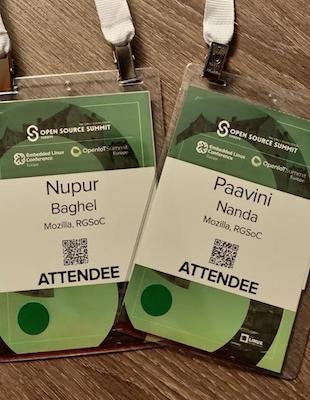
Day 1 - 21/10/18
The day started at 8:00 am with first time attendee breakfast held in the Convention center, Edinburgh. We were in the beginning shy and were not talking to people but then we met Dr.Erik, a very friendly person whom we later found was a part of the OSSEU team. We were surprised. His main message for us to enjoy the conference the most as first time attendees was to plan out the sessions and talks that we wanted to attend, meet new people, talk to them and learn from their experiences.
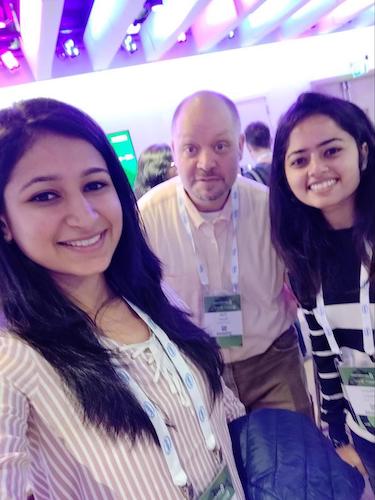
The next thing was the Keynote by Jim Zemlin, Director Linux Foundation
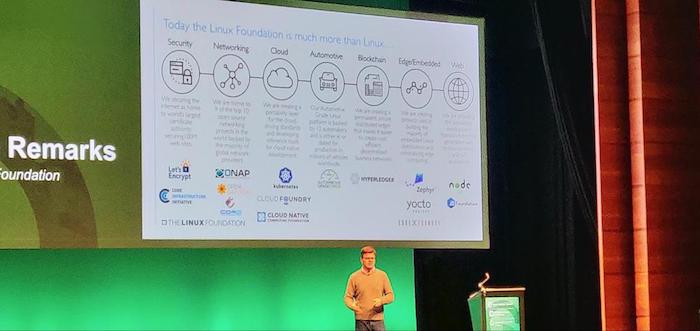
He gave an overview of all the projects that were going on in Linux foundation ranging from cloud computing, blockchain to automotive. He discussed about how the several tracks at OSS EU were going to be. He also mentioned about the diversity empowerment summit which we were very happy to hear about. He discussed about Linux has grown shows how open source has grown over the years Then there was a line of speakers for the keynote. Shuli Goodman, Executive director, LF energy discussed about how she and her team want to reduce 94% of carbon dioxide within the next 10 years. She mentioned that she is looking for 10K developers to help her run this initiative.
Then the next thing that we did was attending Laura’s session on Inclusion and Diversity.

She talked about the problems that people face while working for open source. Big companies are supporting open source but many people don’t get paid, so they work on weekends. So only people who can afford can contribute. She discussed about the problems that arise in having biases in workplaces that is what happens when homogenous group of people make a product. She gave the example of 2015 flickr auto tagging incident where black men were being tagged as ape, and the video of the soap dispenser that got viral because when a black hand was put below it, it didn’t dispense but when a white napkin was put, it did. She also talked about the amazon’s recruiting tool which was biased and discarded the resumes if it had the word “women” in it. So she explained why there is a need to be aware of such unexpected consequences. Finally, she discussed about how the open source projects can be made more accessible. Some points were proper documentation, making the project easy to understand, making the project welcoming, making the guidelines to report bugs, adding tags to the issues which can help the beginners find the issues which might be suitable for them. Her concluding statement was “Open source is about people !!!” to which we all absolutely agreed.
We then interacted with lots of Sponsors who had set up booths and collected some swags. It was very interesting to explore so many open source organisations all under one roof and know about their projects and the awesome work that they are doing.
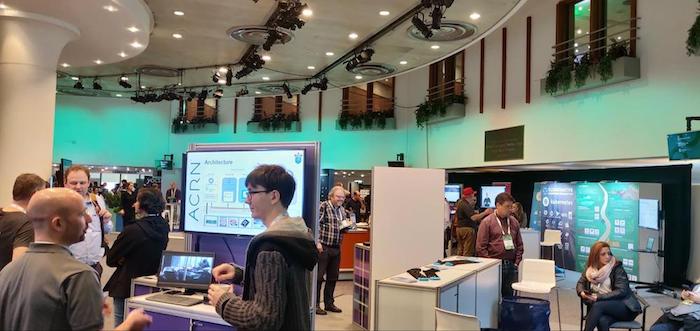
It was almost lunch time by the time we ended up visiting the booths, so we went to attend the Women in Open Source lunch by Adobe at Sheraton Grand. There we met so many other awesome women, some of who were already in their full time jobs and were a way more experienced in open source than us.

Next, we attended a session on Machine Translation by - Suneel Marthi. He explained how he and his team at Amazon tried building a German to English language translator and discussed the intricacies of the problem.
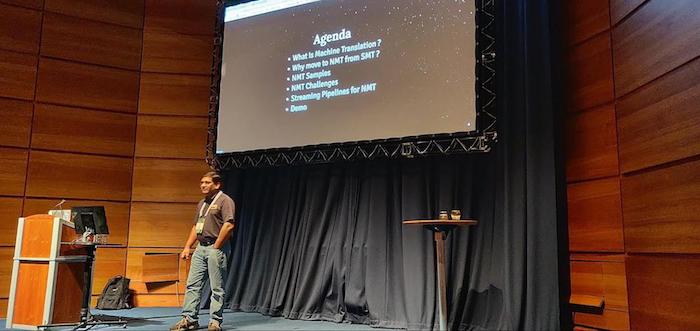
The talk broadly discussed about Statistical(SMT) and Neural(NMT) methods to solve this problem. Statistical methods included making alignment functions on the basis of word positions, phrase based conversions etc. In context to Neural methods, attention based mechanism and byte-pair encoding was discussed. It was interesting to note that the latter was a paper by the University of Edinburgh who had won several competitions using this. There was also a brief talk on Sockeye, Flink and Amazon Sagemaker which were the platforms tried and tested by Suneel.
Next in line was the session on Scalable Machine Learning with Kubeflow by Barbara Fusinska.
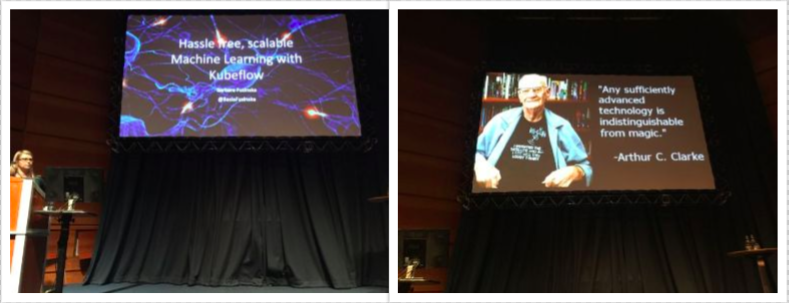
The major aspects covered in this talk were the questions, what is machine learning, deep learning and artificial intelligence? It felt like a discovery to know that Kubeflow was actually the amalgamation of Kubernetes + Tensorflow! We discussed how data scientist’s viewed any problem. The architecture for any problem had three major components: algorithm choosing, model building and model choosing plus serving. Different technology stacks which can be used for these three parts was further taken into consideration. It was a light talk made interactive with QA session and fun quotes such as the one shown above! P.S. The quote on the shirt of the scientist above said “I invented the satellite but all I got was this lousy t-shirt” :)
The day ended with the All-Attendee Reception held at the National Museum of Scotland. It was a beautiful place with people dressed in traditional clothes and bagpiper music filling the air. We also got a glimpse of the statue of Dolly, the first cloned sheep.The live performance by the energetic performers further cheered up everyone. We met people from working on linux kernel and media streaming and went back happily to our warm and cozy hotels.
Day 2 - 22/10/18
This day started with the keynote sessions on varied topics -
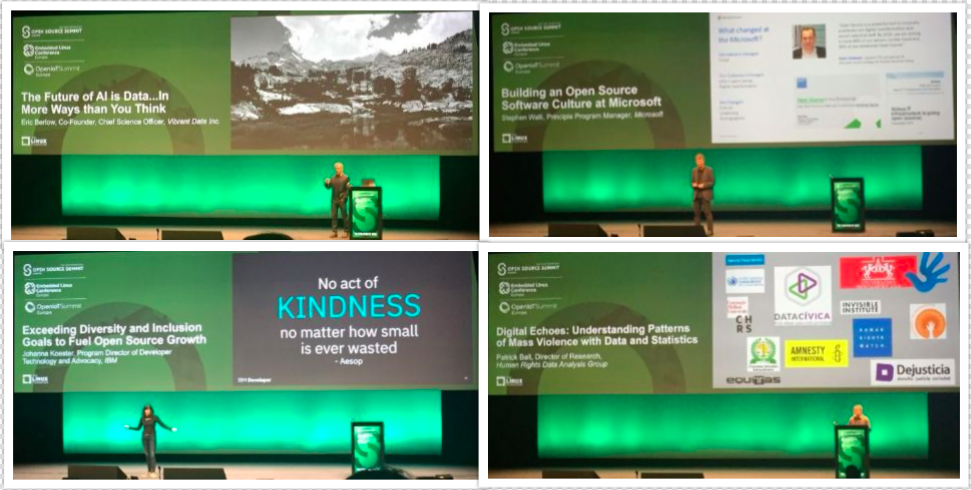
The first talk was The Future of AI is Data by Eric Berlow, who is the Co-founder of Vibrant Data. It focussed on highlighting how data obtained from various sources such as nature, science etc. could be used to simulate the behavior of people. For eg. he considered prisoners who had a painting in their cells. He noted that their nature would depend a lot on the emotions which were depicted in this painting. Two metrics, mood and arousal was considered -
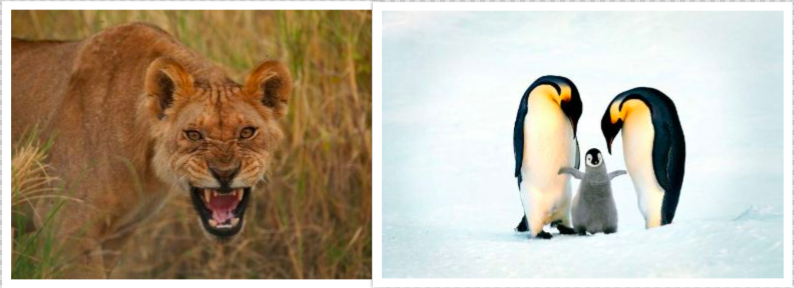
The left image is an example of predators displaying low mood and high arousal, whereas the right image shows high mood and high arousal. Thus, pictures falling under the category of the right image would be good in simulating a positive mood and should hence be used.
The next keynote session was by related to Building an Open Source Culture at Microsoft by Stephen Walli. A lot of things have been changing with Microsoft acquiring github and participating in Open Source. The changes within Microsoft include the changes in industry, which is the cloud; changes in customers, which are several new organisations which work together in partnership as well as the culture, leaders and demographics over the world.
The third keynote for the day, Exceeding Diversity and Inclusion Goals to Fuel Open Source by Johanna Koester, highlighted what diversity actually meant. It didn’t just imply inclusion of all genders and races, but also the diversity of ideas. Successful stories of people from under-represented groups and their contributions were also highlighted.
The last keynote was on Understanding Patterns of Mass Violence with Data and Statistics by Patrick Ball, who is a Human Rights leader. He undertook two differing examples to highlight the correctness of methodologies selected as well as the biases in data which should be taken into account. These included data obtained from mortality in Chadian prisons from 1980s and homicides committed by police in the US 2005-2011. It was sad to know about the suffering of people as well as the biases in data which could have further prevented suitable help being given to them.
After this was a break, and we went to the sponsor showcase to interact with more people whom we couldn’t meet yesterday. Red hats from red hat were really cute and we couldn’t stop ourselves from clicking selfies :P
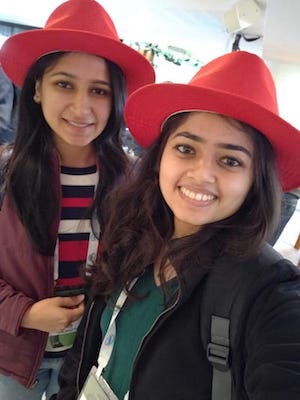
Next began more rounds of sessions and we made sure to visit a good mix of all varieties - Revitalising Open Source Contributions and Participation across Mozilla by Daniel and Riccardo. They talked about the Open innovation project in which they had analysed data from various open source communities. Bitergia Analysis Dashboard represented visualisation from this data. Various models called Archetypes were suggested for different types of projects such as the audience vs governance model, general vs specific model. An example to clear out this difference was the fact that the android and wiki project differed completely.

Making Community Decisions without Consensus by George Dunlop. The major problem as highlighted was to take decisions in non-consensus. The example of Xenproject was clearly presented. They became aware of a vulnerability called XSA-7 intel sysret, they informed all the members who were on the predisclosure list. However, one of the companies in this list missed this message. They came to know about it pretty late and hence they caused public release date to be delayed. This was abused as the company misusing the privilege of being on the predisclosure list. The main problem was thus, to decide who should be in this list. To answer this questions, we needed to find the best solution and do it in such a way, that everyone’s voice should be felt like heard. If we could achieve this, we can solve any problem without consensus.
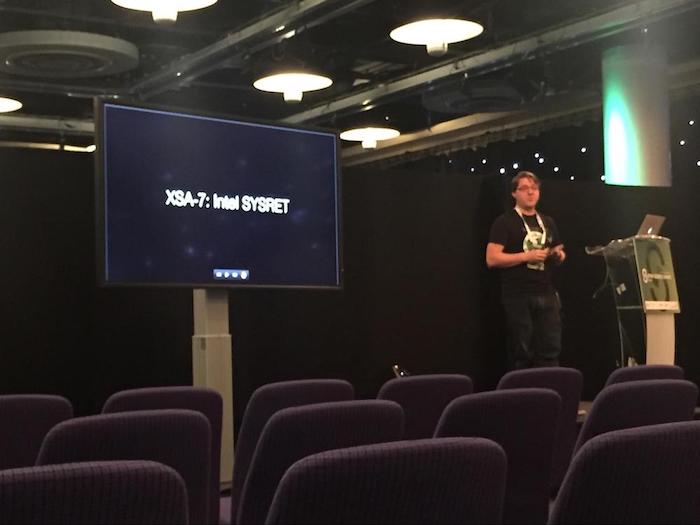
Panel discussion: Outreachy Linux Kernel internship report - Moderated by Julia Lawall. It began with an introduction about Linux Kernel and Outreachy. It was more of a 5 minute talk by three outreachy interns who talked about what they did in their internship with Linux Kernel. The discussion ended with the topic about how the Outreachy program can be expanded more and how the involvement of women in open source can be increased.
Day 3 - 23/10/18
I thoroughly enjoyed the keynotes held on the third day which related to astronomy and physics, loving open source, game design and banking.
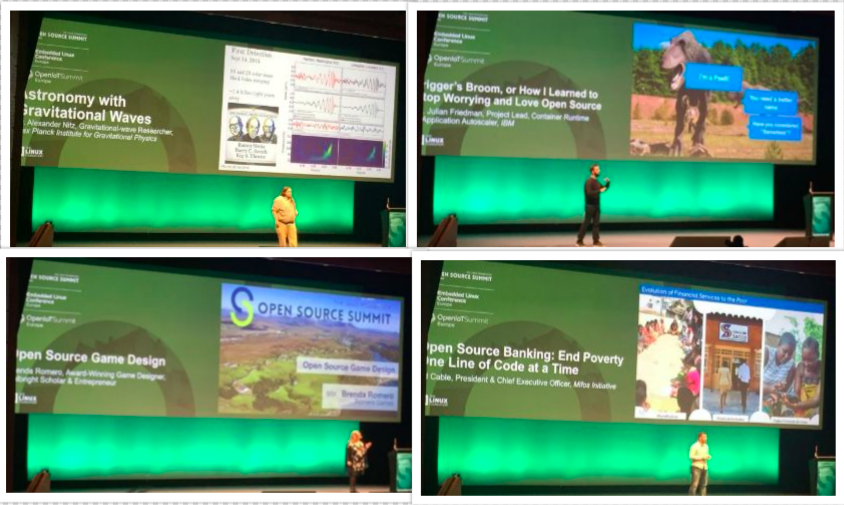
The first keynote was called Astronomy with Gravitational Waves by Alexander Nitz We deep dived into the universe understanding what are neutron stars and black holes. We heard a recording made when a black hole was created in space!!! We also tried to understand the concept behind binary mergers and various experiments which are currently active over the world. It was amazing to know so much about science in open source.
The second keynote was about How to Stop Worrying and Love Open Source by Julian Friedman. This talk was told in the form of a story, with the hero being cloud foundry and the villain as kubernetes. There was a fun joke where a person said that he had been using the “same broom since over 20 years”, just that he had changed the stick 25 and the brushes 17 times :P He introduced Eirini which is a container orchestration of cloud foundry as relating to this, using the same brush with different sticks. His talk ended with a list of awesome 5 learnings!
The third keynote was called Open Source Game Design by Brenda Romero. It was for the first time I heard of this concept. Usually game designers were silent to their developments and won’t share the details. Brenda told us about her journey about how she started into this field, how one of her projects which was on a sensitive issue became popular. How she managed about this issue, since a sensitive situation couldn’t be publicized and how she once revealed her complete set of game ideas to another developer even “before it was built”, which is the concept of open source game design!
The final keynote on Open Source Banking by Ed Cable expressed how we could tackle Poverty. He had been involved with the Mifos initiative which is open sourcing the bank infrastructure, and helping fight poverty by including greater sections of people to get financial help.
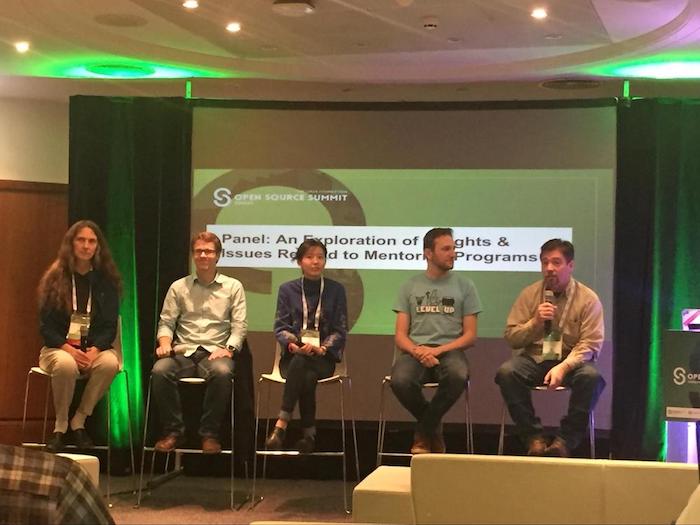
Next there was a mentorship panel discussion on Exploration of Insights and Issues Related to Mentoring Programs. The speakers involved were Hong Phuc Dang, Josh Simmons, Julia Lawall, Daniel Izquierdo and Jeffrey Osier-Mixon with Jeffrey as the moderator. The topics of discussion were value of mentoring, different types, metrics and mentoring & diversity. The values which a mentor gained included improving communication skills and learning to represent the same things in a better way. Open source was described as a very intimidating field to a newcomer.It has various learning layers and becomes difficult to understand how to start, etiquettes involved, etc. Types of mentoring program were long term, short term, cohort/peer mentoring, corporate, and formal vs informal. The session ended with an analysis on cases where people who had been mentored, got involved with the community for a longer time. Hence, good mentoring plays an important role in motivating students and building communities.
After this, we met our super supportive mentor Josh and Manish for lunch. Josh had guided and motivated us throughout the whole span of our contributions and could be credited for the successful completion of the RGSoC project. (Thank you so much mentor :P) We had a great time meeting both of them face to face at last!
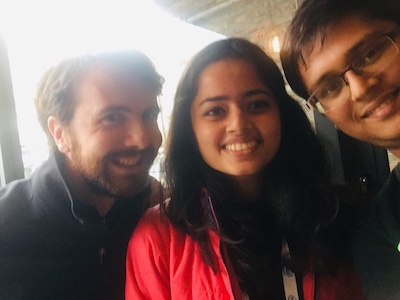
Post lunch, we attended one more session and the closing game which was lively, and fun-filled! The session was titled Improving the human Vector with Emoji by Vincent Batts. The basic idea of the talk was that currently fingerprinting is done by humans which is prone to errors. This is because usually we do not match the long string of chars but just look at the first and last two hexadecimal characters. Other example where such checking is involved include containers digests, shaID, etc. Each emoji basically combines 2 hexadecimals, thus instead of looking at the first and last chars, we would now be looking at more chars. This was a simple idea to be taken but the learnings were bigger - Don’t take yourself too seriously; laugh at poor choices, otherwise things get too rigid Open source these days involving business and vp decisions is not so good. People under commit and over deliver because of time constraints. Thus, don’t be hasty Take a deep breath; toy with something unrelated and not critical Look for accepted norms with weak assumptions; Like for our case, did looking at first and last two emojis make any difference? Challenge accepted norms!
Conclusion:
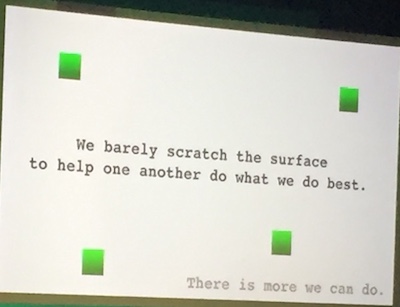
It was truly inspiring to see various fields being associated so closely with Open source. It is time all of us come together and help out each other for a better tomorrow. Cause, there is more we can do !!
The Open Source Summit was a good learning experience. We met amazing people, made lasting networks, got motivated to work more for the open source community and the linux kernel, had amazing food (although slightly limited because of vegetarian dietary restrictions), visited beautiful castles in the heartwarming city with a lovely weather and made memories :) We are extremely thankful to the RGSoC community, Mozilla and Linux Foundation who made it possible for us! ❤️ Hoping to visit again next year!